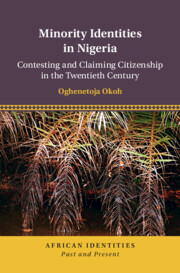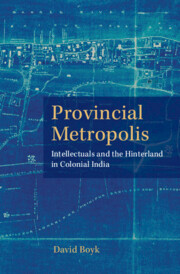Refine search
Actions for selected content:
615759 results in History

An Empire of Images
- Visual Culture and the British in India, 1688–1815
-
- Published online:
- 26 September 2025
- Print publication:
- 16 October 2025

Chips from a Calcutta Workshop
- Comparative Religion in Nineteenth Century India
-
- Published online:
- 26 September 2025
- Print publication:
- 16 October 2025

Minority Identities in Nigeria
- Contesting and Claiming Citizenship in the Twentieth Century
-
- Published online:
- 26 September 2025
- Print publication:
- 16 October 2025
For their Own Ends: Universalist Idealism and Political Pragmatism in Late Colonial Human Rights Reforms
-
- Journal:
- Itinerario , First View
- Published online by Cambridge University Press:
- 26 September 2025, pp. 1-17
-
- Article
-
- You have access
- Open access
- HTML
- Export citation
The Archive of Displacement: Vernacular History and Urban Cemeteries in Oran, Algeria
-
- Journal:
- Comparative Studies in Society and History , First View
- Published online by Cambridge University Press:
- 26 September 2025, pp. 1-28
-
- Article
-
- You have access
- Open access
- HTML
- Export citation
Biblical love song as Chinese literature: the Song of Songs in the Delegates’ Version
-
- Journal:
- Journal of the Royal Asiatic Society , First View
- Published online by Cambridge University Press:
- 26 September 2025, pp. 1-17
-
- Article
- Export citation
Jan Dumolyn and Jelle Haemers, Communes and Conflict. Urban Rebellion in Late Medieval Flanders. [Historical Materialism, Vol. 289.] Brill, Leiden 2024. xvi, 470 pp. € 195.11. (E-book: € 195.11).
-
- Journal:
- International Review of Social History , First View
- Published online by Cambridge University Press:
- 26 September 2025, pp. 1-3
-
- Article
-
- You have access
- HTML
- Export citation
Jill A. Schennum, As Goes Bethlehem. Steelworkers and the Restructuring of an Industrial Working Class. Vanderbilt University Press, Nashville (TN) 2023. 299 pp. $99.95. (Paper: $39.95; E-book: $19.99.)
-
- Journal:
- International Review of Social History , First View
- Published online by Cambridge University Press:
- 26 September 2025, pp. 1-3
-
- Article
-
- You have access
- HTML
- Export citation
The Power of the Anecdotal: Enlightening Work Practices in Premodern Eurasia using Word and Image
- Part of
-
- Journal:
- International Review of Social History , First View
- Published online by Cambridge University Press:
- 26 September 2025, pp. 1-28
-
- Article
-
- You have access
- Open access
- HTML
- Export citation
Remaking a Sovereign Landlord: Property and Dispossession Along the Basra Oil Frontier
-
- Journal:
- Comparative Studies in Society and History , First View
- Published online by Cambridge University Press:
- 26 September 2025, pp. 1-27
-
- Article
-
- You have access
- Open access
- HTML
- Export citation
Under the Eagle’s Wings: The Coca-Cola Company’s Trademark Protection and Its Dilemmas in China (1930–1949)
-
- Journal:
- Enterprise & Society , First View
- Published online by Cambridge University Press:
- 26 September 2025, pp. 1-25
-
- Article
- Export citation
Martyrs, Dreams, and Past Lives: Insurgent Immortality and the Expansive Logic of Debt
-
- Journal:
- Comparative Studies in Society and History , First View
- Published online by Cambridge University Press:
- 26 September 2025, pp. 1-25
-
- Article
-
- You have access
- Open access
- HTML
- Export citation
Aura Piccioni, Römische Großbronzen am Limes: Fragmente im raetischen Raum (BAR International Series S3133). Oxford: BAR Publishing, 2023. Pp. xxx + 286, illus. isbn 9781407314990 (pbk), £84.00; 9781407315072 (e-format).
-
- Journal:
- Britannia , First View
- Published online by Cambridge University Press:
- 26 September 2025, pp. 1-2
-
- Article
- Export citation
One Cross, Two Continents: How Catholic Women’s Resistance in Mexico Inspired Their Spanish Counterparts (1926–1936)
-
- Journal:
- Comparative Studies in Society and History , First View
- Published online by Cambridge University Press:
- 26 September 2025, pp. 1-22
-
- Article
-
- You have access
- Open access
- HTML
- Export citation

The Byzantine and Early Islamic Near East
- Elites Old and New
-
- Published by:
- Gerlach Books
- Published online:
- 25 September 2025
- Print publication:
- 31 January 2021

The 'Constitution of Medina'
- Muḥammad's First Legal Document
-
- Published by:
- Gerlach Books
- Published online:
- 25 September 2025
- Print publication:
- 31 January 2024

The Place to Go
- Contexts of Learning in Baghdad, 750-1000 CE
-
- Published by:
- Gerlach Books
- Published online:
- 25 September 2025
- Print publication:
- 31 January 2021

Studies in Early Islamic History
-
- Published by:
- Gerlach Books
- Published online:
- 25 September 2025
- Print publication:
- 31 January 2021

The Byzantine and Early Islamic Near East
- States, Resources and Armies
-
- Published by:
- Gerlach Books
- Published online:
- 25 September 2025
- Print publication:
- 31 January 2021

Provincial Metropolis
- Intellectuals and the Hinterland in Colonial India
-
- Published online:
- 25 September 2025
- Print publication:
- 04 September 2025
